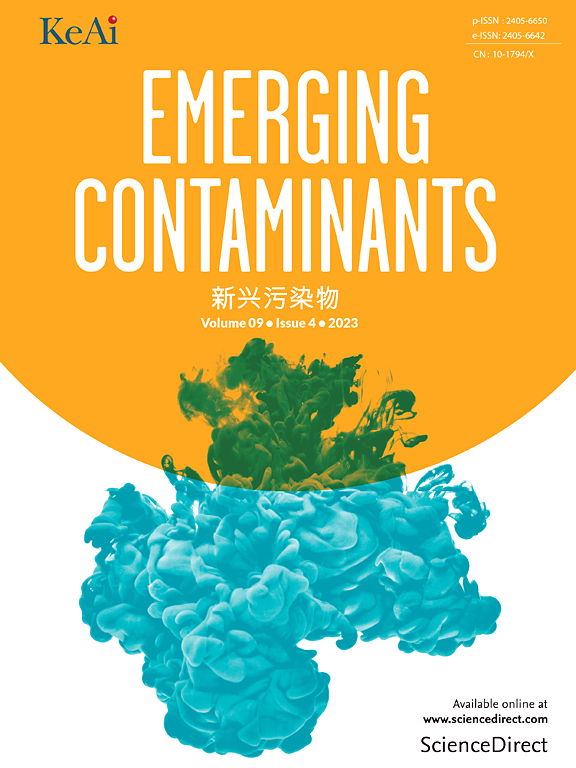In-vitro metabolites characterization of 1,3-diphenylguanidine and 1,3-di-o-tolylguanidine by high-resolution mass spectrometry and urinary profiling
IF 6.9
2区 环境科学与生态学
Q1 ENVIRONMENTAL SCIENCES
引用次数: 0
Abstract
The discovery of the hazardous effects associated with the polymer additives 1,3-diphenyl guanidine (DPG) and 1,3-di-o-tolylguanidine (DTG) has prompted the need for biomonitoring studies to detect human exposure. However, limited information is available about their metabolism. To address this gap, this study investigates the Phase I and II in-vitro biotransformation of both chemicals using human liver microsomes and cytosol. The samples were analyzed using liquid chromatography coupled to high resolution-(tandem) mass spectrometry through suspect (of in-silico predicted metabolites) and non-target screening. The analysis revealed four Phase I and two Phase II metabolic products for both DPG and DTG. Hydroxylation of the benzene ring led to the tentative identification of mono- and di-hydroxylated metabolites. Subsequent Phase I deamination followed by oxidation resulted in the formation of hydroxy-phenylurea and an intramolecular cyclization resulted in the formation of hydroxy-cyclic products. Furthermore, N-glucuronidation and O-glucuronidation products were identified for the first time. After performing urinalysis, DPG and DTG could be quantified in the 0.02–0.23 μg L−1 range, and DPG-227 (mono-hydroxylated DPG) was estimated to be present at ca. 0.01–0.10 μg L−1 range, using DPG response as quantification surrogate. Finally, toxicity assessment using an in-silico tool indicated the need to consider these human metabolites in (eco)toxicological assessments, as they may have the same or even greater effects on humans and the environment.
用高分辨率质谱和尿液谱分析鉴定1,3-二苯基胍和1,3-二-邻-多聚胍的体外代谢物
聚合物添加剂1,3-二苯基胍(DPG)和1,3-二-邻-多聚胍(DTG)的有害影响的发现促使人们需要进行生物监测研究,以检测人体暴露。然而,关于它们新陈代谢的信息有限。为了解决这一差距,本研究调查了使用人肝微粒体和细胞质的化学物质的I期和II期体外生物转化。通过可疑(计算机预测的代谢物)和非目标筛选,使用液相色谱法和高分辨率(串联)质谱法对样品进行分析。分析显示,DPG和DTG均有4个I期代谢产物和2个II期代谢产物。苯环的羟基化导致了单羟基和双羟基代谢物的初步鉴定。随后的I期脱胺反应和氧化反应生成羟基苯基脲,分子内环化反应生成羟基环产物。此外,还首次鉴定了n -葡萄糖醛酸化和o -葡萄糖醛酸化产物。尿液分析后,DPG和DTG在0.02 ~ 0.23 μg L−1范围内可被定量,DPG-227(单羟基化DPG)在0.01 ~ 0.10 μg L−1范围内可被定量。最后,使用计算机工具进行的毒性评估表明,需要在(生态)毒理学评估中考虑这些人体代谢物,因为它们可能对人类和环境具有相同甚至更大的影响。
本文章由计算机程序翻译,如有差异,请以英文原文为准。
求助全文
约1分钟内获得全文
求助全文
来源期刊

Emerging Contaminants
Medicine-Public Health, Environmental and Occupational Health
CiteScore
10.00
自引率
6.70%
发文量
35
审稿时长
44 days
期刊介绍:
Emerging Contaminants is an outlet for world-leading research addressing problems associated with environmental contamination caused by emerging contaminants and their solutions. Emerging contaminants are defined as chemicals that are not currently (or have been only recently) regulated and about which there exist concerns regarding their impact on human or ecological health. Examples of emerging contaminants include disinfection by-products, pharmaceutical and personal care products, persistent organic chemicals, and mercury etc. as well as their degradation products. We encourage papers addressing science that facilitates greater understanding of the nature, extent, and impacts of the presence of emerging contaminants in the environment; technology that exploits original principles to reduce and control their environmental presence; as well as the development, implementation and efficacy of national and international policies to protect human health and the environment from emerging contaminants.
 求助内容:
求助内容: 应助结果提醒方式:
应助结果提醒方式:


